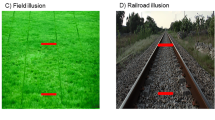Abstract
Texture gradients are systematic variations in projected surface texture. It is expected that image variables such as texture density or size carry information about the surface orientation and distance. This article reexamines the information content of texture gradients and reviews the relevant psychophysics. Slant is shown to be difficult to infer from a texture gradient, but tilt (the direction of slant) is easily and reliably determined. Regarding distance, a new texture measure is introduced that has a simple geometric definition, and from which distance can be readily computed. Variables affecting the precision and the accuracy of the distance computation are discussed.
Similar content being viewed by others
References
Bajcsy, R.: Computer identification of textured visual scences. Memo AIM-180, Stanford University (1972)
Bajcsy, R., Lieberman, L.: Texture gradients as a depth cue. Comput. Graph. Image Proc. 5, 52–67 (1976)
Beck, J.: Texture-gradients and judgments of slant and recession. Am. J. Psychol. 73, 411–416 (1960)
Braunstein, M.: Motion and texture as sources of slant information. J. Exp. Psychol. 78, 247–253 (1968)
Braustein, M., Payne, J.W.: Perspective and form ratio as determinants of relative slant judgements. J. Exp. Psychol. 81, 584–590 (1969)
Brodatz, D.: Textures. New York: Dover 1966
Clark, W.C., Smith, A.H., Rabe, A.: The interaction of surface texture, outline gradient, and in the perception of slant. Can. J. Psychol. 10, 1–8 (1956)
Epstein, W., Park, J.: Examination of Gibson's psychophysical hypothesis. Psychol. Bull. 62, 180–196 (1964)
Flock, H.R.: Three theoretical views of slant perception. Psychol. Rev. 52, 110–121 (1964)
Freeman, R.B.: Ecological optics and visual slant. Psychol. Rev. 72, 501–504 (1965)
Gibson, J.J.: The perception of the visual world. Boston: Houghton Mifflin 1950
Gibson, J.J.: The perception of visual surfaces. Am. J. Psychol. 63, 367–384 (1950)
Gregory, R.L.: The intelligent eye. New York: McGraw-Hill 1970
Haber, R.N., Hershenson, M.: The psychology of visual perception. New York: Holt, Rinehart, and Winston 1973
Ikeuchi, K.: Shape from regular patterns (an example of constraint propagation in vision). M1T AI Lab. Memo 567 (1980)
Julesz, B.: Foundations of cyclopean perception. Chicago: University of Chicago Press 1971
Kender, J.R.: Shape from texture: An aggregation transform that maps a class of textures into surface orientation. Proc. IJCAI 1980, 475–480 (1980)
Marr, D.: Representing visual information. A.A.A.S. 143rd Annual Meeting, Symposium on: Some mathematical questions in biology, February 1977. In: Lectures on mathematics in the life sciences, Vol. 10, pp. 10–180 (1978)
Marr, D., Hildreth, E.: Theory of edge detection. Proc. R. Soc. Lond. B207, 187–217 (1980)
Marr, D., Poggio, T.: From understanding computation to understanding neural circuitry. Neurosci. Res. Prog. Bull. 15, 470–488 (1977)
Purdy, W.C.: The hypothesis of psychophysical correspondence in space perception. General Electric Technical Information Series. No. R60ELC56 (1960)
Rosinski, R.R.: On the ambiguity of visual stimulation: A reply to Eriksson. Percept. Psychophys. 16, 259–263 (1974)
Smith, O.W., Smith, P.C.: Interaction of the effects of cues involved in judgments of curvature. Am. J. Psychol. 70, 361–375 (1957)
Stevens, K.A.: Representing and analyzing surface orientation. In: Artifical Intelligence: An MIT perspective Winston, P.H., Brown, R.H. (eds.) pp. 104–125. Cambridge: MIT Press 1979
Stevens, K.A.: The visual interpretation of surface contours. Artifical Intelligence (1981) (in press)
Witkin, A.P.: Recovering surface shape and orientation from texture. Artifical Intelligence (1981) (in press)
Author information
Authors and Affiliations
Rights and permissions
About this article
Cite this article
Stevens, K.A. The information content of texture gradients. Biol. Cybern. 42, 95–105 (1981). https://doi.org/10.1007/BF00336727
Received:
Issue Date:
DOI: https://doi.org/10.1007/BF00336727




